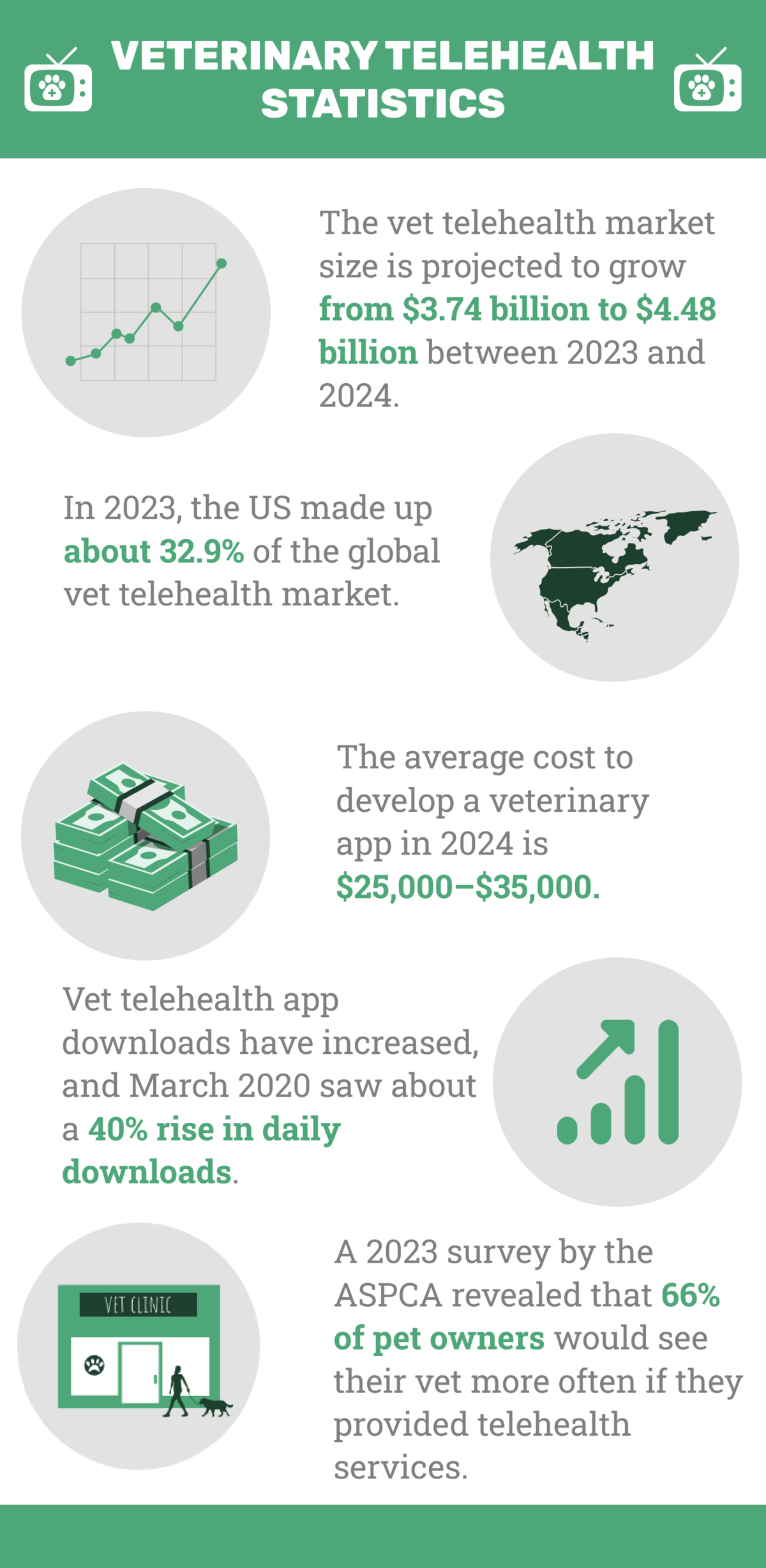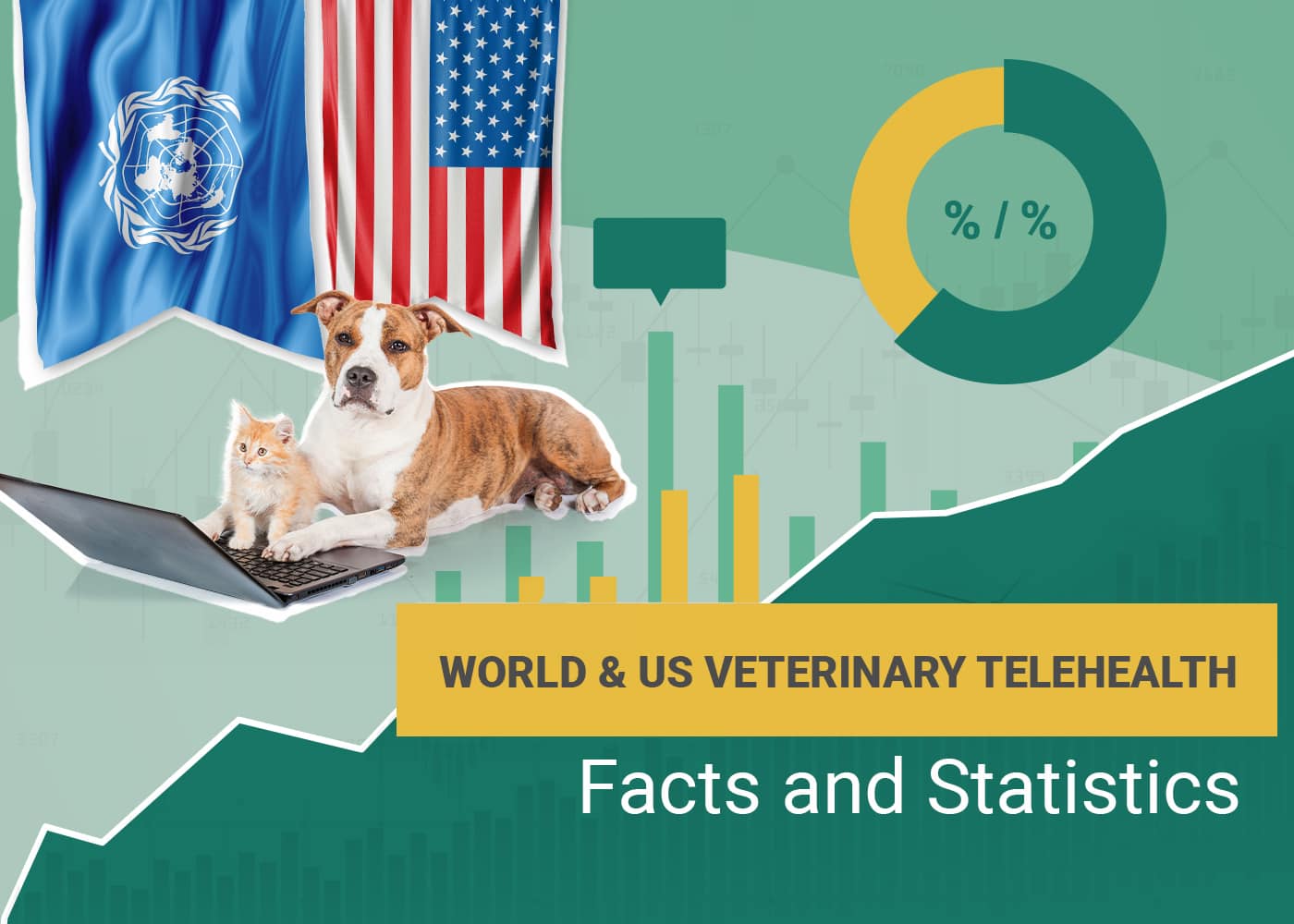Click to Skip Ahead
Note: This article’s statistics come from third-party sources and do not represent the opinions of this website.
Veterinary telehealth services have become more prominent, particularly during the COVID-19 pandemic. While vet practices have resumed in-person appointments, a push for vet telehealth continues to exist. Investors continue to fund vet telehealth companies and services, and many of these companies have been refining their products and expanding their reach.
With the use of vet telehealth being relatively new, there are mixed opinions about how beneficial it is. Overall, time will tell just how effective vet telehealth will be for the average pet owner and if it can be developed to become a normalized aspect of pet care. Here are the latest trends and statistics regarding vet telehealth.

The 12 Veterinary Telehealth Statistics
- On a global scale, the vet telehealth market is projected to expand at a 17.7% CAGR by 2034.
- The vet telehealth market size is projected to grow from $3.74 billion to $4.48 billion between 2023 and 2025.
- In 2023, the US made up about 32.9% of the global vet telehealth market.
- According to 2022 trends, Asia Pacific is the global region estimated to have the fastest growth rate for vet telemedicine.
- Vet telehealth is a high-investment market, with FirstVet, one of the largest online pet health services, receiving $29.3 million in Series C funding in 2025.
- The average cost to develop a veterinary app in 2025 is $25,000–$35,000.
- With about 1 million cases of zoonotic diseases registered each year, industry experts anticipate a continued increase in pet telehealth solutions.
- Vet telehealth app downloads have increased, and March 2020 saw about a 40% rise in daily downloads.
- A 2023 survey by the ASPCA revealed that 66% of pet owners would see their vet more often if they provided telehealth services.
- A 2023 survey found that about 12% of dog owners and 6% of cat owners have used pet telemedicine.
- Many pet owners may need to start using vet telehealth, as veterinary care shortages may cause about 75 million pets to be without veterinary care by 2030.
- According to a 2022 study of 20,000 telemedicine exams, only 17% of these exams resulted in a vet prescribing medication.

The Global Veterinary Telehealth Market
1. On a global scale, the vet telehealth market is projected to expand at a 17.7% CAGR by 2034.
(Globe Newswire)
The vet telehealth market is a promising market for investors. It has faced continuous growth throughout the COVID-19 pandemic and had its largest revenue share of 29.19% in 2023. Market researchers anticipate steady growth to continue through 2034.
2. The vet telehealth market size is projected to grow from $3.74 billion to $4.48 billion between 2023 and 2025.
(The Business Research Company)
Several factors contribute to the anticipated growth of the vet telehealth market. It’s becoming a more viable option for pets with chronic health issues, and it gives pet owners who are immobile or don’t have reliable transportation easier access to veterinary care. Vet telehealth technology also continues to improve and advance, particularly with the incorporation of AI.

3. In 2023, the US made up about 32.9% of the global vet telehealth market.
(Grand View Research)
The US has the largest vet telehealth market in the world. Leaders in the US vet telehealth industry are currently focused on competitive pricing strategies, product and service expansion, and sales and marketing initiatives. We’ve also seen more mergers and acquisitions in the past few years.
4. According to 2022 trends, Asia Pacific is the global region estimated to have the fastest growth rate for vet telemedicine.
(Markets and Markets)
Despite the large size of the North American market, Asia Pacific is expected to surpass and develop the largest vet telehealth market in the next few years. More countries in this region are experiencing growing disposable income levels, and pet ownership continues to increase significantly. More pet owners in this region are also more willing to spend money on animal healthcare.


Funding and Investing in Veterinary Telehealth
5. Vet telehealth is a high-investment market, with FirstVet, one of the largest online pet health services, receiving $29.3 million in Series C funding in 2025.
(TELUS)
Vet telehealth is in a high market growth stage with an accelerating market growth pace. Therefore, many investors continue to provide significant funding to companies in this market. Notably, pet telehealth companies have received large amounts of Series A, B, and C funding from investors. For example, FirstVet recently received $29.3 million to expand its reach to North America and continue with product development.
6. The average cost to develop a veterinary app in 2025 is $25,000–$35,000.
(USM)
The cost of creating a new veterinary app will depend on the types of services you want to include. Factors like video conference calls, user accounts, pet profile creations, and shopping features can all affect how much an app costs. Prices will also vary depending on if you hire an app development company or freelancers.

7. With about 2.5 billion cases of illnesses caused by zoonotic diseases each year, industry experts anticipate a continued increase in pet telehealth solutions.
(Princeton)
Since the early 2000s, we’ve seen a significant rise in zoonotic diseases. COVID-19 and monkeypox are recent examples of zoonotic diseases that have impacted people worldwide. Various factors have impacted the increase in cases of zoonotic diseases, including environmental changes and population growth. Since zoonotic diseases can affect humans and animals, experts are anticipating the increased use of vet telehealth services to help meet the need for veterinary care.

Pet Ownership and Veterinary Telehealth Apps
8. Vet telehealth app downloads have increased, and March 2020 saw about a 40% rise in daily downloads.
(Forbes)
More pet owners are becoming aware and interested in vet telehealth apps. As many people resorted to telehealth services during the COVID-19 pandemic, many pet owners also relied more on vet telehealth. The number of daily downloads for vet telehealth apps has stabilized slightly after the pandemic. However, these apps still have promising futures, especially as their scope of services continues to improve.

9. A 2023 survey by the ASPCA revealed that 66% of pet owners would see their vet more often if they provided telehealth services.
(ASPCA)
Many pet owners don’t have adequate, consistent access to veterinary care. Some barriers to veterinary care include costs, transportation, and access to clinics. Therefore, missing appointments or routine physical exams isn’t always attributed to forgetfulness or negligence. Vet telehealth may help lessen the barriers that pet owners face by making veterinary care more accessible and affordable for them. Most notably, people would be able to provide medical attention for their pets without having to leave their homes.
10. A 2023 survey found that about 12% of dog owners and 6% of cat owners have used pet telemedicine.
(NIH)
Despite its growing market, a survey found that most dog and cat owners haven’t ever used pet telemedicine. This survey suggests that a lack of clarity and understanding about pet telemedicine is making pet owners hesitant about using it. As pet telemedicine is still relatively new, more pet owners may be convinced of using it if their vets provide clarity surrounding its benefits.

11. Many pet owners may need to start using vet telehealth, as veterinary care shortages may cause about 75 million pets to be without veterinary care by 2030.
(Banfield)
Veterinary care shortages have been an issue in pet ownership for decades, as the current veterinary care system hasn’t been able to keep up with the growing rate of pet ownership in the US. If current trends persist, about 75 million pets may not have access to veterinary care by 2030. Vet telehealth services may help address the growing need by promoting efficiency and making veterinary care and support accessible to more pet owners.
12. According to a 2022 study of 20,000 telemedicine exams, only 17% of these exams resulted in a vet prescribing medication.
(Veterinary Practice News)
One limitation of pet telemedicine is that it may not be sufficient for vets to make diagnoses and prescribe medication. This survey found that only a small percentage of virtual appointments resulted in prescriptions for pets. Roughly ⅓ of these appointments resulted in the vet recommending an in-person appointment for a more thorough examination.


Frequently Asked Questions About Veterinary Telehealth
Can a veterinarian prescribe medication through a telehealth app?
Telehealth is a broad term for a variety of veterinary care services. Most vet telehealth apps offer tele-triage, which is when a vet can provide general advice on caring for a pet and recommend patients see a vet in person if the pet requires thorough or immediate attention. Vets can’t diagnose or prescribe medication through tele-triage services.
In some cases, vets can provide telemedicine services to their clients. When a vet uses telemedicine, they have an established relationship with the pet owner and pet and can diagnose and prescribe medication.
It’s important to remember that access to veterinary medicine depends on where you live. Pet telemedicine laws vary from state to state, so it’s not readily available in every state.
Who benefits the most from vet telehealth apps?
Currently, vet telehealth is catered to people who have limited access to traditional veterinary care and for pets with chronic health issues who would normally require multiple vet visits a year. Vet telehealth can help reduce costs because virtual appointments are less expensive, and people can save on transportation costs.
Veterinary telehealth can also benefit veterinary practices by making office operations more efficient. For example, clients would be less likely to schedule in-person appointments for situations that end up being false alarms.

Can vet telehealth appointments replace in-person appointments?
No, vet telehealth appointments currently can’t replace in-person appointments. Pets should still go to their annual check-ups so that their vets can thoroughly assess their health. Some cases of accidents and unexpected illnesses also require extensive examination in order for vets to make a correct diagnosis.
What are the main advantages of veterinary telehealth?
Vet telehealth can give pet owners peace of mind because it enables easy access to a veterinarian. Since most vet telehealth apps operate 24/7, you can connect with a veterinarian much more quickly and at any time of day or night if your dog gets sick. Vet telehealth apps can also help people who don’t live near a vet clinic by saving them a long drive and having pets seen by a veterinarian from the comfort of their homes.
What are the main disadvantages of veterinary telehealth?
The disadvantage of veterinary telehealth is that it’s more limited than in-person appointments. Vets are limited in their observations, as they can’t record a pet’s vitals and must only rely on what they see with their eyes to assess a pet’s condition.
Vet telehealth also remains a bit ambiguous and uncertain for pet owners. Some are hesitant about using it because they’re not sure what to expect.

Conclusion
Vet telehealth is a growing industry, and it’s projected to keep growing for the next several years. Despite the large investments going into vet telehealth companies and services, many pet owners aren’t utilizing vet telehealth. It’s possible that continued investment in product development and technology can increase its appeal and make it a more valuable service that more pet owners can start to rely on and use.










